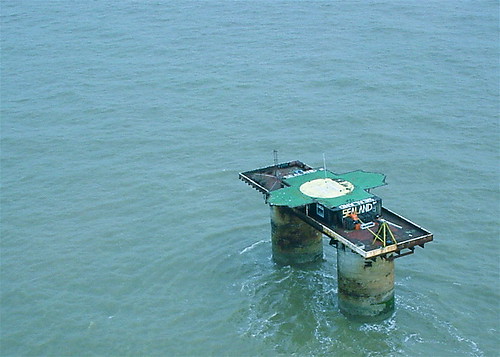Principality of Sealand is a WWII-era gunnery platform — called Roughs Tower — in the North Sea, outside Britain’s pre-1968 three nautical mile claim of sovereign waters. Founded by Roy and Joan Bates in 1967, over time, Roy wrote a constitution and named himself and Joan as prince and princess.
The Wikipedia article on Sealand tells the story of the world’s smallest micronation about as well and evenly as might be possible, but Sean Hastings’ website offers a more gripping tale. Hastings is one of the founders of HavenCo, the company that made big news in 2000 by entering into an agreement with Sealand to operate a datahaven there. HavenCo and Sealand were the subject of a July 2000 article in Wired magazine. A number of pictures of modern Sealand can be found at Metacolo.com, a site that claims a mission similar to HavenCo’s.
Interestingly, Sealand’s soverignty has been upheld in a handful of small cases that faced the British courts. The first, in 1968, resulted from warning shots being fired on an advancing boat. Sovereignty, we know, is best proved in battle. And that’s what makes Hasting’s telling of the 1978 war so enthralling:
In August of 1978, a number of Dutch men came to Sealand in the employ of a German businessman. They were there to discuss business dealings with Sealand. While Roy was away in Britain, these men kidnapped Prince Roy’s son Michael, and took Sealand by force. Soon after, Roy recaptured the island with a group of his own men and held the attackers as prisoners of war.
During the time that he held the prisoners, the Governments of the Netherlands and Germany petitioned for their release. First they asked England to intervene in the matter, but the British government cited their earlier court decision as evidence that they made no claim to the territory of Sealand. Then, in an act of de facto recognition of Sealand’s sovereignty, Germany sent a diplomat directly to Sealand to negotiate for the release of their citizen.
Roy first released the Dutch citizens, as the war was over, and the Geneva Convention requires the release of all prisoners. The German was held longer, as he had accepted a Sealand Passport, and therefore was guilty of treason. Prince Roy, who was grateful that the incident had not resulted in a loss of life, and did not want to bloody the reputation of Sealand, eventually released him as well.
Roy’s knowledge of how British law applies to sea platforms likely came from his dabbling in ‘pirate’ radio which started in 1965 on Knock John Tower, another offshore gunnery platform. In 1966 he was charged, and a failed appeal in 1967 apparently set the groundwork for Roy’s later declaration of sovereignty on Roughs Tower. One report quotes the judge in that appeal as saying “it appears to this court that the Knock John Tower is about 1 1/2 miles inside inland waters.” Roughs Tower stands about seven miles into the North Sea, while Knock John Tower stood only a mile and a half off the coast.
But don’t cue the Sealand national anthem yet. Matt Roseberg is pretty sure Sealand is not a country and in How to Start Your Own Country Erwin S. Strauss tells of a number of failed attempts and described’s Sealand only as “the most successful new-country venture known.”
Related: micronations in the Yahoo! Directory, Wikipedia’s list of places with fewer than ten people, and Erwin S. Strauss’ How to Start Your Own Country.
